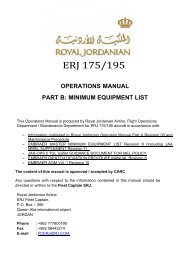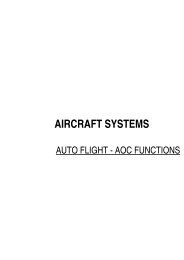You also want an ePaper? Increase the reach of your titles
YUMPU automatically turns print PDFs into web optimized ePapers that Google loves.
A330/A340<br />
FLIGHT CREW<br />
OPERATING MANUAL<br />
Applicable to: MSN 0970-1002<br />
DISENGAGEMENT CONDITIONS<br />
<strong>AIRCRAFT</strong> <strong>SYSTEMS</strong><br />
AUTO FLIGHT - FLIGHT GUIDANCE<br />
AP/FD COMMON MODES - TAKEOFF<br />
The SRS mode disengages:<br />
‐ Automatically, at the acceleration altitude (ACC ALT), or if ALT* or ALT CST* mode engages<br />
(above 400 ft RA)<br />
‐ If the flight crew engages another vertical mode<br />
‐ If the flight crew selects a speed while in SRS mode: SRS reverts to OP CLB mode, and a<br />
triple-click aural warning is heard.<br />
Note: In Engine Out conditions, the SRS mode does not automatically disengage at EO ACC<br />
ALT. Refer to DSC-22_20-60-40 General.<br />
Applicable to: MSN 0014-0043<br />
GUIDANCE<br />
In SRS mode, the aircraft maintains a speed target equal to V2+10 kt in normal engine<br />
configuration. When the FMGES detects an engine failure, the speed target becomes the highest<br />
of V2 or current speed, limited by V2+15 kt.<br />
The SRS guidance law also includes:<br />
‐ Attitude protection to reduce aircraft nose-up effect during takeoff (15 ° or 22.5 ° maximum in<br />
case of windshear)<br />
‐ Flight path angle protection that ensures a minimum climb slope of 0.5 °.<br />
Note: If during takeoff the flight crew inadvertently sets an altitude on the FCU below the<br />
current altitude, the aircraft will remain in SRS mode until the flight crew takes some<br />
other action.<br />
RJA A330/A340 FLEET DSC-22_30-80-20 P 2/4<br />
FCOM ← B → 30 MAY 12






